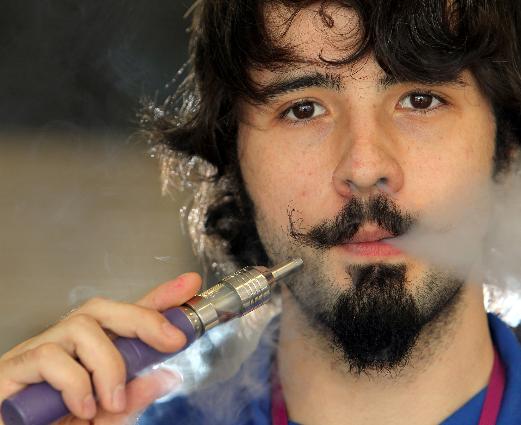E-cigarette ads model big tobacco ads of old
Jolie Lee, USA TODAY Network
Correction: An earlier version of this story included a quote that suggested the Food and Drug Administration regulated alcohol. The FDA does not have jurisdiction over alcoholic beverages.
Some e-cigarette companies are following in the marketing footsteps of tobacco companies: celebrity appeals and flavors that could attract kids. The Food and Drug Administration restricts how regular cigarettes are advertised, but e-cigarettes fall into a loophole for federal regulation.
The head of the Centers for Disease Control and Prevention said these new kinds of cigarettes threaten the next generation and some members of Congress are urging the FDA to regulate e-cigarette ads as well.
About 4 million Americans now use e-cigarettes and sales have grown dramatically since 2010, according to the Tobacco Vapor Electronic Cigarette Association. E-cigarette manufacturers have cited their product’s potential to get smokers to give up tobacco cigarettes.
But critics of e-cigarettes have raised concerns that the industry is targeting non-smokers, including young people. The CDC says 10% of middle and high students have tried e-cigarettes, a rate that doubled from 2011 to 2012.
Here’s a look at how e-cigarette ads compare to tobacco marketing strategies, many of which targeted young people.
Ads in front of kids
Vype e-cigarettes were advertised in a children’s iPad game last month.
British Tobacco Company, the owner of Vype, apologized for the ad placement, citing a “breach of protocols by third party used by ad agency,” according to a company tweet.
Decades earlier — before they were pushing vitamins, the Flintstones were lighting up Winstons in a 1960 commercial.
“Cigarette ads have always tried to exploit kids’ aspirations that they want to be glamorous, rugged, rebellious,” said Vince Willmore, spokesman for the Campaign for Tobacco-Free Kids. “Now e-cigarettes are appealing to those same aspirations.”
The FDA is considering expanding regulations to the e-cigarette industry, including how products are advertised. TVECA’s position is that e-cigarettes should be regulated like tobacco, co-founder Tom Kiklas said, noting the possibility that localities could impose strict regulations on the use of e-cigarettes unless the FDA provides guidelines for their sale.
Cartoon mascots
E-cigarette company eJuiceMonkeys has a smiling, smoking monkey as its mascot.
Camel started using the cartoon Joe Camel in its advertising campaigns starting in 1988. Joe Camel retired in 1997 — the same year big tobacco reached a $365 billion settlement, which included an end to marketing to kids.
Fun flavors
E-cigarettes come in a variety of flavors, including chocolate, gummy bears and evenwaffles topped with maple syrup and butter. To get in the fall spirit, V2 Cigs offers a pumpkin spice e-cigarette
The Food and Drug Administration banned flavors for regular cigarettes in 2009, saying cigarettes characterizing fruit, candy and cloves “have special appeal for children.”
Kiklas, though, disputes the need to extend these regulations to e-cigarettes. He cited the FDA’s approval of cherry-flavored nicotine lozenges. “Is that marketing to kids?” he said.
“We support any flavor that assists in a smoker’s transition to e-cigarettes,” he said.
Before the FDA ban on flavored cigarettes, Camel was offering tropical flavors such as “Kauai Kolada” with a hint of pineapple and coconut, as well as “Twista Lime.”
Kids in ads
The British e-cigarette company E-Lites features a baby dancing Gangnam-style. The U.K.’s Advertising Standards Authority banned the ad on TV and radio.
This Marlboro ad from the 1950s shows another family-friendly scene — a little boy sailing a paper boat with his dad while he’s smoking a cigarette.
Credit: From the collection of Stanford University (tobacco.stanford.edu)
E-cigarette company Bull Smoke tweets, “Everybody is doing it!” with pictures of celebrities, including movie stars Katherine Heigl and Dennis Quaid, reality TV star JWoww and actor Kevin Connolly.
The tobacco industry enacted a self-imposed ban on ads featuring entertainers, athletes and personalities in 1964. Before then, tobacco companies used A-list stars to sell their product.

